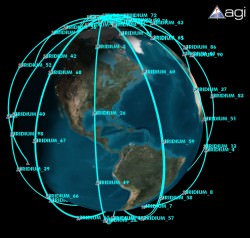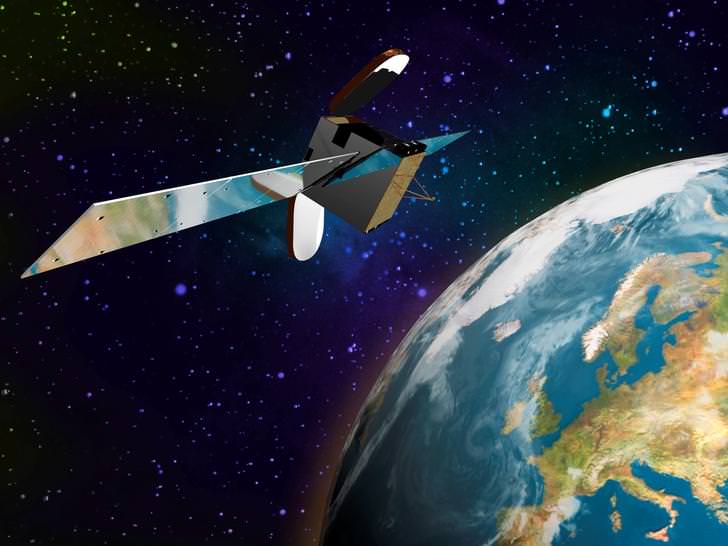[/caption]
On Tuesday, a communications satellite in the Iridium fleet suffered complete obliteration at the hands of a defunct Russian satellite Cosmos 2251. Although satellites have been hit by space junk in the past (four times since 1996), this is the first time a satellite has suffered a direct hit… from another satellite. The aftermath of the collision was messy and US Space Command is tracking hundreds of pieces of debris. There is some concern the ex-satellite parts could collide with other active satellites or even the International Space Station (although the odds are still well within safety margins for the crew), but much effort is being put into tracking and modelling the new space junk additions.
If you thought AGI was quick at assembling those superb satellite animations only a day after the event, you’ll be even more impressed with the company who lost their expensive piece of kit. Iridium has a replacement satellite. A spare. Already in orbit. And plans are afoot to “plug the hole” in the satellite phone network. Now that’s what I call service!

Although Iridium was concerned about patchy service for some customers, the satellite network’s mesh design will lower the likelihood of any service outages. So put your satellite phone away, the signal should still be strong.
“The Iridium service hole patch addresses a significant portion of outages that customers otherwise might have experienced,” said Iridium spokesperson Liz DeCastro. “Due to the mesh design of the Iridium network, the company expects further impact to customers to be limited.”
So it sounds as if it’s a sturdy network that can easily deal with one lost component, but the best was yet to come in the press release. “The company also is taking the necessary steps to replace the lost satellite with one of its in-orbit spares, and the operational planning stage is underway,” DeCastro added.
Naturally, Iridium is investigating the incident, saying that they are working “with the appropriate government agencies”. At this time it is unclear whether Iridium will be seeking compensation from the Russian government, but this is a possibility. After all, dead satellites should either be de-orbited or moved from the paths of operational satellites. Unfortunately for Iridium 33, Cosmos 2251 was left at an altitude used by commercial satellite companies.
There may be no LEO traffic control, and there is certainly no “right of way” in space, the responsibility to dispose of space junk lies with the satellite’s last owner. In this case, that would be Russia.
Sources: Tech Radar, Iridium Press Release


@syzygy: OK, let’s try “dying” instead of “dead”. Better? I think you get my point – unfortunately many satellites are just left up there at the end of their lifespan with no consideration for the junk that’s left over. Even if Cosmos 2251 died suddenly with no warning, it is still the responsibility of the entity who put it up there. In this case, it seems to be the Russian government.
@Salacious B. Crumb: I think most of your answers can be found here: http://en.wikipedia.org/wiki/Iridium_(satellite)
Cheers!
Ian 🙂
It is Service indeed !!!
“After all, dead satellites should either be de-orbited or moved from the paths of operational satellites.”
If it’s dead then it can’t me moved or de-orbited.
Unless you have a new definition of “dead”.
I suggest “bundled orbiting” the earth as an alternative to the actually practised “orbital individualism”.
For it is not realy necessary for each and every task in space is performed on a autonomous single satellite. On the contrary, the hardware for those tasks could in many cases be bundled on a “space carrier”, a plattform that does harbor a diversity of services and tasks for a multitude of customers. By the way, a synonym for those host plattforms is the word “space station”!
It is a precondition for the developement of such a space infrastructure, that the earth orbit is grouped into “orbit channels” or “orbital corridors”. Those channels comprise a quantity of optimal orbits, otherwise traversed by all those single vehicles.
Thus, a small number of plattforms would orbit the world compared to the large number of single sattelites which would otherwise carrying tasks individualy.
The companies that provide the plattforms would offer a basic set of services. They would provide the framework and the power supply among others, also installation of hardware on the plattform, maintenance and repair and more, e.g. the gyroscopes for alignment. Even a variety of antennas could be part of the framework. The plattforms would be designed modular and thus extendable, with nodes and docking ports.
Customers could lease or buy their place on these International Space Plattforms, ISPs. Orbital traffic would be reduced, costs would be reduced and instead of only one ISS, we suddenly would have many.
How many Iridium satellites are there?
What is the Iridium life-span of the whole system?
@Salacious B. Crumb: the system was called Iridium because there are 77 satellites, and 77 is the atomic number of the element Iridium. I don’t know if 77 is the number with or without the spares, but the link Ian pasted should help.
@Ian – does anyone know which Iridium satellite. I haven’t seen it published.
I’ve been mildly interested in their spares since I was showing a Cub pack an Iridium flare and saw a double last year. Periodically I’ve checked to see if the same bird(s) came overhead and if the sight was repeatable.
See http://mangsbatpage.433rd.com/2008/09/double-iridium-flare-spotted-at-433rd.html
It was Iridium 33 as noted by Heavens Above.
If only my phone company was that good at sorting problems.
I agree that whoever puts stuff up in space should have the forsight & consideration to sort out disposing of it.
Did rthey get the spares off Ebay – that WOULD be a cracker of a recycling job!!
ouch! Tried for 10 minutes to retrieve that info by internet research a few days ago in vain and then gave it up. I would guess, that everybody else here already knew, except for me.
So I am finally enlightened, too. Danke!
Mang says “Iridium 33”.
“At this time it is unclear whether Iridium will be seeking compensation from the Russian government, but this is a possibility.”
Good luck with that!
Ian,
Today I bought a book of Ovid, a Roman ancient poet.
As the post about Pluto is far, I’ll write you here the Roman point of view .
Well, he says also that Hades was the place of the deads, and the name of the God too. But, as the people didn’t like to say it, they prefered to call the God with the name Pluto that means wealth in Greek.
This is the Roman version 🙂
Not sure where you got that image, but it’s not an Iridium satellite. It’s a 3-axis geosynchronis satellite, but Iridium is a LEO satellite. Iridium’s solar panels are mounted at an angle on the side. I can send you an Iridium satellite image if you want one.